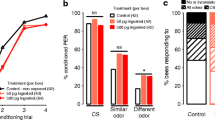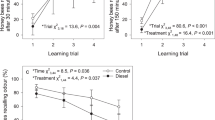Abstract
While the ecological effects of pesticides have been well studied in honeybees, it is unclear to what extent other anthropogenic contaminants such as air pollution may also negatively affect bee cognition and behaviour. To answer this question, we assessed the impacts of acute exposure to four ecologically relevant concentrations of a common urban air pollutant—diesel generated air pollution on honeybee odour learning and memory using a conditioned proboscis extension response assay. The proportion of bees that successfully learnt odours following direct air pollution exposure was significantly lower in bees exposed to low, medium and high air pollutant concentrations, than in bees exposed to current ambient levels. Furthermore, short- and long-term odour memory was significantly impaired in bees exposed to low medium and high air pollutant concentrations than in bees exposed to current ambient levels. These results demonstrate a clear and direct cognitive cost of air pollution. Given learning and memory play significant roles in foraging, we suggest air pollution will have increasing negative impacts on the ecosystem services bees provide and may add to the current threats such as pesticides, mites and disease affecting colony fitness.

Similar content being viewed by others
References
Amorim JH, Valente J, Cascão P, Pimentel C, Miranda AI, Borrego C (2013) Pedestrian exposure to air pollution in cities: modelling the effect of roadside trees. Adv Meteorol 964904
Bitterman ME, Menzel R, Fietz A, Schafer S (1983) Classical-conditioning of proboscis extension in honeybees (Apis mellifera). J Comp Psychol 97:107–119
Brown A, Berman P (1970) Mechanism of excitation of Aplysia neurons by carbon dioxide. J Gen Physiol 56:543–558
Eigenbrod C, Gruda N (2015) Urban vegetable for food security in cities. A review. Agron Sustain Dev 35:483–498
Eiri DM, Nieh JC (2012) A nicotinic acetylcholine receptor agonist affects honey bee sucrose responsiveness and decreases waggle dancing. J Exp Biol 215:2022–2029
Erber J (1976) Retrograde amnesia in honeybees (Apis mellifera carnica). J Comp Physiol Psychol 90:41
Faulkner M, Russell P (2010) Review of local air quality management: A report to Defra and the devolved administrations. Final report to UK Department for Environment, Food and Rural Affairs, January 2010. Retrieved from Retrieved from https://webarchive.nationalarchives.gov.uk/20130403063841/http://archive.defra.gov.uk/environment/quality/air/airquality/local/documents/laqm-report.pdf
Gallai N, Salles J-M, Settele J, Vaissière BE (2009) Economic valuation of the vulnerability of world agriculture confronted with pollinator decline. Ecol Econ 68:810–821
Garbuzov M, Ratnieks FL (2014) Quantifying variation among garden plants in attractiveness to bees and other flower‐visiting insects. Funct Ecol 28:364–374
Girling RD, Lusebrink I, Farthing E, Newman TA, Poppy GM (2013) Diesel exhaust rapidly degrades floral odours used by honeybees. Sci Rep 3:2779
Gulia S, Nagendra SS, Khare M, Khanna I (2015) Urban air quality management–a review. Atmos Pollut Res 6:286–304
Irga P, Burchett M, Torpy F (2015) Does urban forestry have a quantitative effect on ambient air quality in an urban environment? Atmos Environ 120:173–181
Irga P, Torpy F (2017) Reducing indoor air pollution through horticultural biotechnology. In Green infrastructure: nature-based solutions for sustainable and resilient cities. Orvieto, Italy, 2017. Retrieved from http://hdl.handle.net/10453/92908
Kamyotra J, Mahwar R, Saxena R, Thirumurthy G, Puri M, Debroy R (2010) Status of the vehicular pollution control programme in India. Central Pollution Control Board, Ministry of Environment and Forests, Government of India: New Delhi, India
Kim K-H, Kabir E, Kabir. S (2015) A review on the human health impact of airborne particulate matter. Environ Int 74:136–143
Kirkerud NH, Wehmann H, Galizia CG, Gustav D (2013) APIS—a novel approach for conditioning honey bees. Front Behav Neurosci 7:29
Klein S, Cabirol A, Devaud JM, Barron AB, Lihoreau M (2017) Why bees are so vulnerable to environmental stressors. Trends Ecol Evol 32:268–278
Klein A-M, Vaissiere BE, Cane JH, Steffan-Dewenter I, Cunningham SA, Kremen C, Tscharntke T (2007) Importance of pollinators in changing landscapes for world crops. Proc R Soc Lond B Biol Sci 274:303–313
Kumar MK, Nagendra SS (2015) Characteristics of ground level CO2 concentrations over contrasting land uses in a tropical urban environment. Atmos Environ 115:286–294
Kwak MM, Velterop O, Andel J (1998) Pollen and gene flow in fragmented habitats. Appl Veg Sci 1:37–54
Leonard RJ, Hochuli DF (2017a) The multifaceted nature of vulnerability in managed bees: a response to klein et al. Trends Ecol Evol 32:633–635
Leonard RJ, Hochuli DF (2017b) Exhausting all avenues: why impacts of air pollution should be part of road ecology. Front Ecol Environ 15:443–449
Leonard RJ, Vergoz V, Proschogo N, McArthur C, Hochuli DF (2019) Petrol exhaust pollution impairs honey bee learning and memory. Oikos 128:264–273
Lusebrink I, Girling RD, Farthing E, Newman TA, Jackson CW, Poppy GM (2015) The effects of diesel exhaust pollution on floral volatiles and the consequences for honey bee olfaction. J Chem Ecol 41:904–912
McFrederick QS, Kathilankal JC, Fuentes JD (2008) Air pollution modifies floral scent trails. Atmos Environ 42:2336–2348
Menzel R, Manz G, Menzel R, Greggers U (2001) Massed and spaced learning in honeybees: the role of CS, US, the intertrial interval, and the test interval. Learn Mem 8:198–208
Namdeo A, Colls J, Baker C (1999) Dispersion and re-suspension of fine and coarse particulates in an urban street canyon. Sci Total Environ 235:3–13
Omholt SW, Amdam GV (2004) Epigenetic regulation of aging in honeybee workers. Sci SAGE KE 2004:pe28
Potts SG, Biesmeijer JC, Kremen C, Neumann P, Schweiger O, Kunin WE (2010) Global pollinator declines: trends, impacts and drivers. Trends Ecol Evol 25:345–353
Schneider CW, Tautz J, Grünewald B, Fuchs S (2012) RFID tracking of sublethal effects of two neonicotinoid insecticides on the foraging behavior of Apis mellifera. PLoS ONE 7:e30023
Seto KC, Fragkias M, Güneralp B, Reilly MK (2011) A meta-analysis of global urban land expansion. PLoS ONE 6:e23777
Stokstad E (2007) The case of the empty hives. Science 316:970–972
Tan K, Chen W, Dong S, Liu X, Wang Y, Nieh JC (2015) A neonicotinoid impairs olfactory learning in Asian honey bees (Apis cerana) exposed as larvae or as adults. Sci Rep 5:10989
Varshney C, Padhy PK (1998) Total volatile organic compounds in the urban environment of Delhi. J Air Waste Manag Assoc 48:448–453
Walker J, Brown A (1970) Unified account of the variable effects of carbon dioxide on nerve cells. Science 167:1502–1504
Williams IH (1994) The dependence of crop production within the European Union on pollination by honey bees. Agric Zool Rev 6:229–257
Williamson SM, Willis SJ, Wright GA (2014) Exposure to neonicotinoids influences the motor function of adult worker honeybees. Ecotoxicology 23:1409–1418
Williamson SM, Wright GA (2013) Exposure to multiple cholinergic pesticides impairs olfactory learning and memory in honeybees. J Exp Biol 216:1799–1807
Wright GA, Schiestl FP (2009) The evolution of floral scent: the influence of olfactory learning by insect pollinators on the honest signalling of floral rewards. Funct Ecol 23:841–851
Acknowledgements
The authors thank T. Latty and C. Perry for feedback during manuscript writing.
Funding
Authors (RJL, TJP, PI, CM and DFH) received no funding for this project.
Authors’ contributions
RJL, TP, PI, CM and DFH conceived the project; RJL collected the data; TP and PI conducted chemical. analyses; RJL, TP, CM and DF wrote the manuscript. All authors gave final approval for publication.
Author information
Authors and Affiliations
Corresponding author
Ethics declarations
Conflict of interest
The authors declare that they have no conflict of interest.
Ethical approval
All applicable international, national, and/or institutional guidelines for the care and use of animals were followed.
Additional information
Publisher’s note Springer Nature remains neutral with regard to jurisdictional claims in published maps and institutional affiliations.
Rights and permissions
About this article
Cite this article
Leonard, R.J., Pettit, T.J., Irga, P. et al. Acute exposure to urban air pollution impairs olfactory learning and memory in honeybees. Ecotoxicology 28, 1056–1062 (2019). https://doi.org/10.1007/s10646-019-02081-7
Accepted:
Published:
Issue Date:
DOI: https://doi.org/10.1007/s10646-019-02081-7




